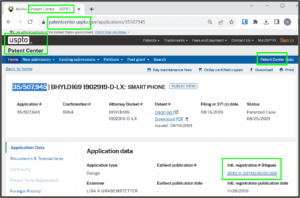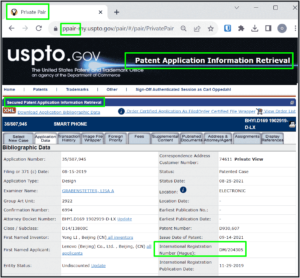
The USPTO announced a couple of days ago that it has picked the date (November 8, 2023) on which it plans to shut down Private PAIR and EFS-Web, leaving its paying customers with nothing to use except the bug-ridden Patentcenter. (See USPTO announces shutdown of EFS-Web and Private PAIR, September 20, 2023.) This decision by USPTO management to shut down Private PAIR and EFS-Web would, perhaps, be a sound decision if several things were true:
-
- if Patentcenter were nearly bug-free (which is is not, see the Patentcenter trouble ticket list showing some eighty-eight outstanding defects); and
- if Patentcenter really did have “100% of the functionality of EFS-Web, Public and Private PAIR” (which it does not (blog article)); and
- if USPTO were communicating with, instead of stonewalling, the practitioners who try to report Patentcenter defects to the USPTO (see December 16, 2021 letter from Seventy-four Members of the Patentcenter Listserv to the USPTO, which remains unanswered to this day); and
- if the USPTO had implemented even a single one of the missing features of Patentcenter that its beta testers have been asking for since 2018 (which the USPTO has not).
The USPTO press release announcing the shutdown of Private PAIR and EFS-Web on November 8, 2023 quotes USPTO Director Kathi Vidal. What Director Vidal may not fully appreciate is that right now in September of 2023, with the planned shutdown of Private PAIR and EFS-Web less than seven weeks away, Patentcenter is still only in beta-test! If anybody who works for Director Vidal is telling her that Patentcenter is actually out of beta-test, and is ready for production service, she needs to know that whoever is telling her this is not telling her the truth.
The most recent proof of this is in the screen shot above, which is repeated here:

This screen shot is from Patentcenter. It is a screen shot from today, September 23, 2023. It shows a US design patent that issued two years ago from International design registration number DM/204305. Another way to describe that US design patent is that it issued from a Hague application (a “35-series” US patent application). What should appear in the green highlighted area at the lower right of this Patentcenter screen shot is the nine characters “DM/204305”, namely the International Registration Number (Hague). But as you can see, what actually appears in the green highlighted area at the lower right of this Patentcenter screen shot is the twenty-three characters “2019-11-29T00:00:00.000”.
Let’s suppose you want accurate information about the International Registration Number (Hague) for this US patent application. As may be seen from the screen shot from Patentcenter, it is not possible to get accurate information from Patentcenter. Is there a place where you can get accurate information about the International Registration Number (Hague) for this US patent application? Yes, there is such a place. It is Private PAIR. Here is a screen shot from Private PAIR, showing the accurate information about the International Registration Number (Hague) for this US patent application:

The pesky little problem is that the USPTO plans to shut down the one accurate source of this information on November 8, 2023.
The magnitude of this particular defect in Patentcenter is, however, far greater than merely displaying wrong information on the computer screen. This field in Patentcenter is a clickable link to the Hague Express database at the World Intellectual Property Organization. The alert reader will have no difficulty guessing where I am going with this. Yes, the clickable link provided by the USPTO on this page of Patentcenter is broken. It goes to a non-functional web page on the web site of WIPO.
Surely, you ask, this must only be a problem in Patentcenter with this single US design patent, right?
No. What you will find is that you can plug in any one of the thousands of 35-series patent applications that is now pending at the USPTO, or that has issued as a US design patent, and … the information provided in Patentcenter is false, and … the information provided in Private PAIR is accurate. And yet it is the accurate system (Private PAIR) that the USPTO top management has decided to shut down on November 8, 2023. And it is the buggy system (Patentcenter) that will be the only system still functioning after November 8, 2023.
This has been added as Patentcenter trouble ticket number CP155.
Surely this is a mere isolated defect in Patentcenter? Surely as a general matter Patentcenter is indeed working well enough that it is not sheer folly for USPTO’s highest management to make a decision to shut down Private PAIR and EFS-Web?
No, with each passing day what USPTO customers find is that something that previously worked in Patentcenter is now broken. It is not merely that there were things that were missing all along that needed to be there, and were never actually implemented (and there are dozens of such things, which belie USPTO’s false claim that “Patent Center has 100% of the functionality of EFS-Web, Public and Private PAIR”). It is not merely that there many dozens of features of Patentcenter have never worked properly, and which have been reported to the USPTO, and that the USPTO has not fixed (and there are dozens of such things). It is not merely that the USPTO has failed to implement even one of the features for Patentcenter that its beta testers have been asking for since 2018 (and there are dozens of such requested features).
No. With each passing day what USPTO customers find is that something that previously worked in Patentcenter is now broken. This means that the Patentcenter developers are lurching from one buggy version of code to the next, and each update of the Patentcenter code breaks things that worked perfectly well in the previous version of Patentcenter code.
There are many examples of this problem of the Patentcenter developers breaking things. Today’s example is the field in Patentcenter that is supposed to display the International Registration Number (Hague) which is an eight-character value such as “DM/204305”. It worked perfectly well for the past two years, and it worked perfectly well until about two days ago. But starting with some code update by the Patentcenter developers within the past two days, this field in Patentcenter is displaying nonsense information such as “2019-11-29T00:00:00.000”.
Another example from a week ago is the Patentcenter Outgoing Correspondence Table. For about a year, and until about a week ago, there was an ellipsis at the far right side of the Patentcenter Correspondence Table. But on about September 18, 2023, the Patentcenter developers updated the code and this ellipsis disappeared. This is trouble ticket CP151. During USPTO’s Patentcenter training event of September 19, 2023, the USPTO presenter acknowledged this disappearance of the ellipsis and said the USPTO mistake will get corrected “in October”.
Yet another set of examples dates from the Patentcenter code version that was released on March 17, 2023. Many features of Patentcenter that worked perfectly before March 17, 2023 were degraded or became broken completely on and after March 17, 2023 — see trouble tickets CP105, CP107, CP110, CP113 and CP114.
These are but a sampling of recent instances in which a release by the USPTO of a new code version for Patentcenter broken something that worked previously in Patentcenter.
What is clear to Patentcenter’s users, but is apparently not clear to the top management at the USPTO, is that Patentcenter is still in beta test. Patentcenter may at some future date be ready for general release as a production system. But that day has not yet arrived, and barring a miracle, that day will not arrive by November 8, 2023.

Turning off an old tool that works for a new one that is not fully operational is straight out of a Dilbert cartoon. Someone’s bonus probably depends on PatentCenter being fully operational by now. And so it is. Collect the bonus and move to a new role. Let the next guy deal with the consequences, and tell everyone they broke it after you left.
Director Vidal should spend a few hours with the EBC support staff that answer calls about PatentCenter and ask them how often they still point users to EFS Web and PAIR. I bet that would be insightful, unless bonus guy got to the support staff first.
One of the greatest opportunities for the USPTO would be to support an API into PatentCenter. Many of the PatentCenter bugs appear to be on the user interface end. Your screenshot is a perfect example: The URL https://patentcenter.uspto.gov/applications/35507945 loads its data from https://patentcenter.uspto.gov/retrieval/public/v2/application/data?applicationNumberText=35507945. That JSON file contains the correct information:
The user interface is what is broken, and does not get fixed. So let’s just open up the underlying API and let private parties develop tools to directly interface with the PatentCenter backend. Docketing systems that download and upload data directly into PatentCenter could provide a significant productivity boost. Forcing everyone to interface with you through a broken UI does the exact opposite.